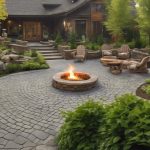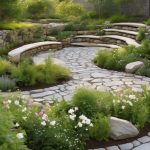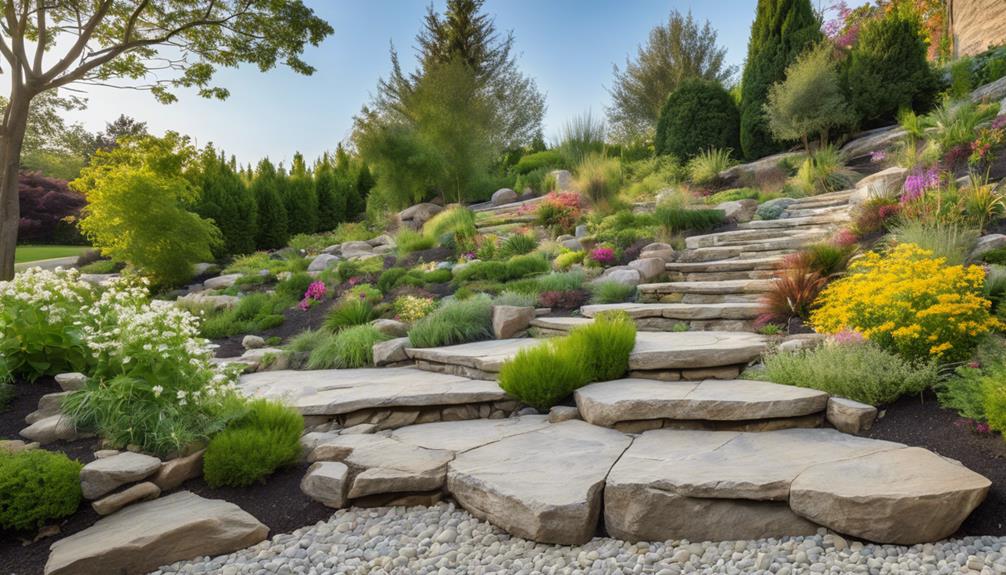
How to Enhance Your Backyard With Hardscaping
20 October 2024
Why Choose Hardscaping for Sloped Gardens?
21 October 2024For successful hardscaping in sloped gardens, focus on three essential tips.
Firstly, implement effective drainage solutions, such as French drains and swales, to prevent soil erosion and manage water runoff.
Secondly, consider using retaining walls to create visually appealing levels while providing necessary support against lateral earth pressure.
Finally, choose deep-rooted plants and ground covers that stabilise soil, enhance aesthetics, and reduce runoff.
These strategies will not only improve the garden's resilience but also its beauty.
Investigate further details to refine your hardscaping techniques and optimise your garden's potential.
Hardscaping Techniques for Slopes
Hardscaping techniques for slopes are vital for creating stable and visually appealing landscapes.
The implementation of retaining walls not only enhances the aesthetic value but also provides structural support to prevent soil erosion.
Furthermore, effective drainage solutions are crucial for managing water flow and ensuring the longevity of hardscaped features.
Retaining Walls Benefits
The strategic implementation of retaining walls offers numerous advantages for sloped gardens, enhancing both functionality and aesthetics.
These structures provide vital support to lateral earth pressure, effectively preventing soil erosion and promoting stability in hilly terrains. In addition, retaining walls create distinct levels within a garden, allowing for more varied planting opportunities and improved accessibility.
By segmenting the landscape, they facilitate the use of different hardscaping elements such as pathways, patios, and seating areas, which can transform a challenging slope into an inviting outdoor space.
Moreover, with a myriad of materials available—ranging from natural stone to concrete—retaining walls can complement existing architecture and landscaping, ultimately elevating the overall visual appeal of the garden while serving key structural purposes.
Drainage Solutions Importance
Effective drainage solutions are crucial for the longevity and health of sloped gardens. Without proper drainage, water accumulation can lead to soil erosion, root rot, and structural instability.
Implementing techniques such as contour grading, French drains, and permeable paving can greatly mitigate these risks. Contour grading creates natural channels for water flow, while French drains facilitate subsurface water movement away from vulnerable areas.
Furthermore, incorporating permeable surfaces allows for water infiltration, reducing runoff and promoting soil health. It is imperative to assess the specific topography and soil composition of your garden to tailor drainage solutions effectively.
Drainage System Design
Effective drainage system design is essential in sloped gardens to mitigate soil erosion and maintain structural integrity.
Implementing proper erosion prevention methods, alongside strategic retaining wall installation techniques, can greatly improve the garden's durability.
Furthermore, selecting the right plants can further stabilise the soil, ensuring long-term success in hardscaping efforts.
Soil Erosion Prevention Methods
Implementing a well-designed drainage system is vital for preventing soil erosion in sloped gardens. A robust drainage strategy not only directs excess water away but also stabilises the soil.
Consider the following methods:
- French Drains: These underground systems collect and redirect water, minimising surface runoff and soil displacement.
- Swales: Shallow, vegetated channels can effectively slow water flow, allowing it to percolate into the ground, thereby reducing erosion risks.
- Terracing: Creating level platforms along the slope interrupts water movement, providing a stable area for plant growth while enhancing aesthetic appeal.
Retaining Wall Installation Techniques
The stability of a sloped garden often hinges on the proper installation of retaining walls, which serve not only as structural supports but also as integral components of a drainage system design.
Effective drainage is vital to prevent water accumulation and soil erosion. Key installation techniques include:
- Site Assessment: Evaluate soil type and slope gradient to determine the appropriate wall height and material.
- Proper Backfill: Use gravel or crushed stone behind the wall to facilitate drainage, preventing hydrostatic pressure build-up.
- Weep Holes: Incorporate weep holes at intervals to allow trapped water to escape, maintaining wall integrity and reducing pressure.
Adhering to these techniques ensures a durable retaining wall that functions effectively within your garden's unique landscape.
Plant Selection for Stability
After establishing a robust retaining wall to manage soil stability and drainage, selecting the right plants is crucial for enhancing the overall effectiveness of the drainage system.
Appropriate plant selection not only contributes to aesthetic appeal but also fortifies the soil through root systems that improve stability.
Consider the following:
- Deep-rooted perennials: Species such as echinacea and daylilies penetrate the soil, creating a strong network that prevents erosion.
- Ground covers: Varieties like creeping thyme and sedum provide coverage, reducing runoff and protecting bare soil from the elements.
- Native shrubs: Plants such as serviceberry and elderberry adapt well to local conditions, offering resilience and support to the drainage system.
Utilising these plant types guarantees a harmonious blend of beauty and functionality in sloped gardens.
Initial Site Assessment
An effective initial site assessment is essential for the successful hardscaping of sloped gardens.
This process involves an extensive site survey and analysis to evaluate the topography, soil conditions, and existing drainage patterns.
Understanding soil compaction techniques and the potential for terracing will further enhance stability and ensure the integrity of the overall design.
Site Survey and Analysis
Conducting a thorough site survey and analysis is crucial for the successful design and implementation of hardscaping in sloped gardens. This initial assessment allows you to understand the unique characteristics of the site, which is pivotal for creating functional and aesthetically pleasing landscapes.
Key elements to evaluate during the site survey include:
- Elevation Changes: Measure the slope's gradient to determine effective drainage and structural support needs.
- Sunlight Exposure: Assess the amount of sunlight different areas receive throughout the day, influencing plant selection and placement.
- Water Drainage Patterns: Identify natural water flow to prevent erosion and ensure the longevity of hardscape materials.
Soil Compaction Techniques Explained
Effective soil compaction techniques are vital in establishing a stable foundation for hardscaping in sloped gardens. Proper compaction minimises soil settlement and improves structural integrity, ensuring your hardscaping withstands the test of time.
Here are three fundamental techniques:
- Moisture Management: Achieve optimal soil moisture content; conditions that are too dry or too wet can hinder effective compaction.
- Layered Compaction: Compact soil in layers, ideally no thicker than 15 centimetres, to ensure uniform density and prevent weak spots.
- Mechanical Tools: Utilise appropriate equipment, such as plate compactors or rollers, to achieve consistent results and penetrate deeper layers.
Terracing for Enhanced Stability
Evaluating the site is crucial for successful terracing in sloped gardens, as it lays the groundwork for improved stability.
A thorough initial site assessment ensures that the terracing design effectively addresses the unique challenges posed by the slope.
Consider the following key factors:
- Slope Angle: Analyse the steepness of the slope to determine the appropriate height and depth of terraces.
- Soil Type: Assess soil composition and drainage capabilities, as these influence structural integrity and plant health.
- Water Flow Patterns: Observe how water flows across the landscape to prevent erosion and ensure proper drainage.
Improved Landscape Aesthetics
The introduction of hardscaping elements in sloped gardens significantly enhances the overall landscape aesthetics. By integrating features such as stone pathways, retaining walls, and decorative patios, one can create visual interest and functional spaces that complement the natural terrain.
| Hardscaping Element | Aesthetic Benefit |
|---|---|
| Stone Pathways | Provides structure and flow |
| Retaining Walls | Defines spaces, adds dimension |
| Decorative Patios | Offers a focal point for gatherings |
| Mulched Planting Beds | Improves colour and texture |
These elements not only enhance the beauty of the garden but also contribute to a cohesive design that harmonises with the surrounding environment. A well-planned hardscape can elevate the overall appeal of sloped gardens, making them more inviting and visually striking.
Garden Design and Planning
Effective garden design and planning on sloped terrains requires careful consideration of diverse hardscaping elements.
Techniques for paver stone layout, the installation of natural stone pathways, and the integration of water features play essential roles in creating a functional and visually appealing landscape.
Paver Stone Layout Techniques
When designing hardscaped areas in sloped gardens, the layout of paver stones plays a crucial role in both aesthetics and functionality. A masterful arrangement of pavers not only enhances visual appeal but also ensures safety and accessibility.
Consider the following techniques:
- Graded Paths: Align pavers to follow the natural contour of the slope, providing a seamless transition that improves stability.
- Pattern Variation: Utilise a combination of large and small pavers to create dynamic visuals, drawing the eye along the path.
- Colour Coordination: Select paver colours that harmonise with surrounding flora, establishing a cohesive landscape design.
Natural Stone Pathway Installation
While installing natural stone pathways in sloped gardens presents unique challenges, careful planning can yield stunning results that enhance both functionality and aesthetics.
Begin by selecting the appropriate type of stone, ensuring it complements your garden's overall design. Next, concentrate on the pathway's layout to create a natural flow that guides visitors through the landscape.
Consider these essential steps:
- Elevation Changes: Design gradual shifts to minimise slipping hazards and improve accessibility.
- Base Preparation: Excavate and level the soil, adding a gravel base for drainage and stability.
- Stone Placement: Lay stones with uniform gaps, allowing for planting or ground cover to soften the edges.
Water Feature Integration Techniques
Incorporating water features into sloped gardens can transform the landscape, offering both visual appeal and soothing sounds that enhance the outdoor experience.
To effectively integrate water features, consider the following techniques:
- Tiered Waterfalls: Create a cascading waterfall that flows down the slope, blending harmoniously with the terrain and enriching the natural soundscape.
- Reflecting Pools: Design shallow reflecting pools at different levels to capture the surrounding beauty, providing a serene focal point amidst the greenery.
- Stream Systems: Install a meandering stream that follows the contours of the slope, promoting biodiversity while guiding visitors through the garden.
Utilising these techniques will not only elevate the aesthetic quality of your sloped garden but also create an immersive, tranquil environment.
Frequent Drainage Issues and Remedies
Effective drainage is vital in sloped gardens to prevent water accumulation and erosion.
Inadequate water diversion strategies can exacerbate these issues, making it necessary to improve water flow management.
This discussion will examine the installation of water diversion systems as a key remedy for ensuring proper drainage in these landscapes.
Inadequate Water Diversion Strategies
Proper water diversion is crucial for maintaining the integrity of sloped gardens, as inadequate strategies often lead to frequent drainage issues.
Ineffective water management can result in soil erosion, plant damage, and unsightly puddles.
To address these challenges, consider implementing the following remedies:
- Install Retaining Walls: These structures can effectively redirect water flow, minimising erosion and providing stability to your garden's terrain.
- Create French Drains: By channelling water away from vulnerable areas, French drains can noticeably reduce excess moisture accumulation.
- Utilise Swales: Shallow, vegetated channels can direct surface runoff while promoting infiltration, enhancing soil health and moisture retention.
Improving Water Flow Management
Managing water flow in sloped gardens is essential to prevent frequent drainage issues that can compromise both aesthetics and plant health.
To effectively improve water management, consider the following remedies:
- Terracing: Creating tiered levels can promote even water distribution, allowing for better absorption and reducing runoff.
- French Drains: Installing these underground systems can redirect excess water away from vulnerable areas, preventing pooling and soil erosion.
- Permeable Pavers: Utilising permeable materials for pathways allows rainwater to filter through, replenishing the soil while minimising surface runoff.
Water Diversion System Installation
Installing a water diversion system is crucial for addressing frequent drainage issues in sloped gardens. Properly managing water runoff can prevent soil erosion, protect plant health, and maintain the structural integrity of hard landscaping features.
Here are three key components to consider during installation:
- Swales: Shallow, vegetated channels that direct water flow and enhance absorption.
- French Drains: Perforated pipes laid in gravel-filled trenches to efficiently redirect excess water away from critical areas.
- Rain Gardens: Strategically placed depressions that capture runoff, promoting infiltration and supporting native plants.
Why Choose TKL Birmingham Gardener
In the realm of transforming sloped gardens into functional and aesthetically pleasing spaces, TKL Birmingham Gardener distinguishes itself through its expertise and dedication.
Their experienced professionals possess extensive knowledge of the unique challenges presented by sloped terrain, crafting bespoke hardscaping solutions tailored to individual landscapes.
Utilising advanced techniques, TKL guarantees effective water management and soil stabilisation, essential components for maintaining the integrity of your garden.
Their commitment to sustainable practices further enhances the ecological health of your space while promoting longevity and ease of maintenance.
With an impressive portfolio that showcases innovative designs, TKL Birmingham Gardener not only elevates the visual appeal of your outdoor area but also enhances its usability, creating a harmonious balance between nature and human ingenuity.
Common Hardscaping Questions Answered
Understanding the intricacies of hardscaping can be intimidating, especially for homeowners looking to improve their sloped gardens. One common question is about drainage; proper planning is fundamental to prevent erosion and water accumulation.
Incorporating retaining walls can effectively manage slopes and enhance aesthetics, but it is critical to select the right materials and designs to ensure stability.
Another frequent query pertains to plant selection; native plants often thrive in these conditions while requiring less maintenance.
Homeowners also frequently wonder about the cost of hardscaping; budgeting should encompass materials, labour, and potential long-term maintenance.
Final Design Review Recommendations
Before finalising your hardscaping design for a sloped garden, it is essential to conduct a thorough review that focuses on functionality, aesthetics, and sustainability.
This ensures that your project not only meets your vision but also performs efficiently in its environment.
Consider the following recommendations:
- Evaluate Drainage Solutions: Confirm that water flows effectively to prevent erosion and pooling, integrating features such as swales or dry riverbeds.
- Select Appropriate Materials: Choose durable, non-slip materials for pathways and terraces that harmonise with the natural landscape and withstand weather conditions.
- Incorporate Native Plantings: Enhance biodiversity by incorporating native flora, which provides ecological benefits and complements the hardscape design.



